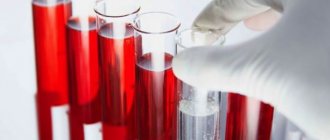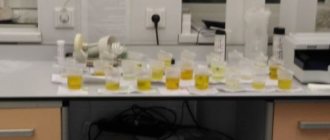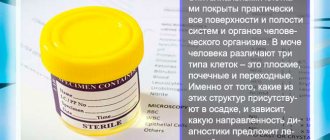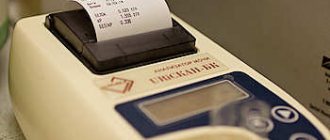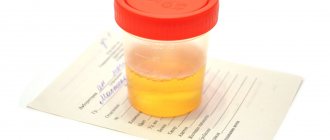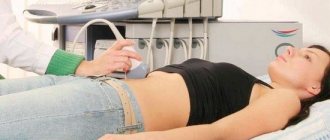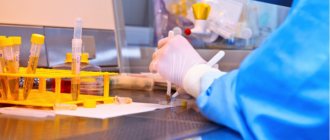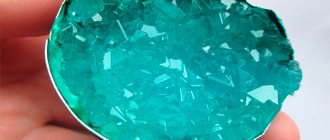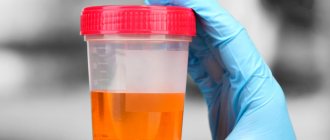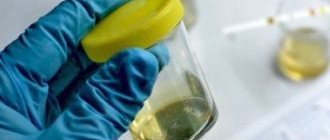Uric acid is
- the end product of purine metabolism; purines do not break down further.
Purines are necessary for the body for the synthesis of nucleic acids - DNA and RNA, energy molecules ATP and coenzymes.
Sources of uric acid:
- from food purines
- from decayed cells of the body - as a result of natural old age or disease
- Uric acid can be synthesized by almost all cells of the human body
Every day a person consumes purines through food (liver, meat, fish, rice, peas). The cells of the liver and intestinal mucosa contain an enzyme, xanthine oxidase, which converts purines into uric acid. Despite the fact that uric acid is the end product of metabolism, it cannot be called “excess” in the body. It is necessary to protect cells from acid radicals, since it can bind them.
The total “reserve” of uric acid in the body is 1 gram, 1.5 grams are released every day, of which 40% is of food origin.
of uric acid is excreted by the kidneys, the remaining 20-25% by the gastrointestinal tract, where it is partially consumed by intestinal bacteria.
Salts of uric acid are called urates , representing a union of uric acid with sodium (90%) or potassium (10%). Uric acid is slightly soluble in water, and the body is 60% water.
Urates precipitate when the environment acidifies and the temperature decreases. That is why the main pain points for gout - a disease of high uric acid levels - are distant joints (big toe), “bones” on the feet, ears, elbows. The onset of pain is provoked by cooling.
An increase in the acidity of the internal environment of the body occurs in athletes and in diabetes mellitus with lactic acidosis, which dictates the need to control uric acid.
The level of uric acid is determined in the blood and urine. In sweat, its concentration is completely negligible and it is impossible to analyze it using publicly available methods.
Increased formation of uric acid directly in the kidneys occurs with alcohol abuse (which is why gout attacks occur more often after heavy drinking) and in the liver - as a result of the metabolism of certain sugars.
Uric acid in the blood is uricemia , and in urine is uricosuria . An increase in uric acid in the blood is hyperuricemia , a decrease is hypouricemia .
Gout is not diagnosed based on the level of uric acid in the blood; symptoms and changes in X-ray images are needed. If uric acid in the blood is higher than normal, but there are no symptoms, a diagnosis of “Asymptomatic hyperuricemia” .
But, without analyzing uric acid in the blood, the diagnosis of gout cannot be considered completely valid.
Signs of pathology development
A high concentration of salts in the urine, if it persists for a long time, provokes the occurrence of urolithiasis or the development of an inflammatory process.
- nausea and vomiting that does not bring relief;
- bitterness in the mouth;
- dryness of the oropharynx;
- hyperthermia;
- weakness and increased fatigue;
- pain and burning when urinating (painful sensations spread along the ureters);
- colic or prolonged unilateral pain in the lumbar region;
- pain or burning when urinating (pain is localized along the location of the ureters);
- reduction in the amount of urine excreted;
- the urine acquires an unpleasant odor and changes color (becomes darker, and sometimes there are signs of blood in it).
In addition to problems in the urinary system when gout occurs, the patient is bothered by pain in the joint (usually the big toes).
- increased excitability;
- poor sleep with frequent awakenings at night.
DETAILS: Enlarged veins in the scrotum
Such children are characterized by increased motor activity and excitability, but at the same time they not only keep up with their peers, but are also slightly ahead of them in development.
In a child, a pathological increase in salts can be associated not only with a disease, but also simply with poor nutrition. In a child’s body, acid-base processes do not always occur stably, and a change in diet can provoke a pH shift to the acidic side, which means that signs of uratomy will appear.
A uric acid test is prescribed:
- if there are symptoms of gout - sharp throbbing pain in the big toe or ankle joint
- in case of gout in direct relatives - for early detection of asymptomatic increases in uric acid levels
- together with other kidney tests to diagnose renal pathology
- to assess risk and prognosis for heart and vascular diseases (coronary heart disease, arterial hypertension, atherosclerosis, myocardial infarction), diabetes mellitus, metabolic syndrome, obesity
- when diagnosing urolithiasis
- during chemotherapy and radiation therapy of cancer, especially leukemia - massive destruction of cells with the release of large amounts of uric acid, which can damage tissue
- in a comprehensive examination for renal failure - after all, it is the kidneys that remove most of the uric acid
- in addition to rheumatic tests to determine the nature of joint inflammation
- to monitor the success of gout treatment
- for diseases and conditions accompanied by an increase in uric acid levels - chronic polycythemia, with prolonged fasting, fasting, alcohol abuse - they are described below.
Norms of uric acid in blood (in µmol/l)
- newborns –140-340
- children under 15 years old - 140-340
- men under 65 years old - 220-420
- women under 65 years old - 40-340
- after 65 years – up to 500
Remember that each laboratory, or rather laboratory equipment and reagents, has its own standards. In the laboratory test form they appear in the column - reference values or norm.
Another unit of measurement for uric acid is mg/dL, which is milligrams per deciliter. It is quite easy to recalculate, since 1 mg/dL = 59.48 µmol/L.
Uric acid in athletes
Physical exercise, especially strength exercise, directly leads to an increase in the concentration of uric acid in the blood, plus a decrease in blood pH during exercise. At the same time, playing sports increases the synthesis of the anti-catabolic hormone testosterone, which promotes the formation of muscle mass, and, as you know, the more muscle, the higher the uric acid. Athletes are also fans of nutritional supplements with proteins and stimulators of testosterone synthesis. All this potentially leads to increased concentrations of uric acid in the blood .
If any joint symptoms appear while playing sports, you need to consult a doctor (preferably sports medicine) and get tested for uric acid (along with other tests).
For those who play sports, you can prevent an increase in uric acid in the blood in the following ways:
- special diet taking into account the type of sport and metabolic state
- drinking enough water
- any sports supplements and pharmaceuticals. Take medications only after consultation with a doctor (at least a trainer), but not on your own!
Diagnostic methods
The main way to diagnose the amount of urate is a general urine test. For testing, urine is collected throughout the day. It should be stored in a cool, dark place, observing personal hygiene rules when collecting.
Before starting to collect material, it is recommended to reduce the consumption of foods containing high amounts of protein, chocolate, coffee, and eliminate alcohol.
If you had to take medications the day before or had an increase in body temperature, you should definitely inform your doctor about this.
If the analysis shows an increased or decreased level of uric acid, it is important to follow the recommendations of your doctor.
What affects the result of a uric acid test?
- dietary habits – the higher the consumption of animal products, the higher the level of uric acid in both the blood and urine
- age - the older a person is, the more cells in his body are completing their life cycle, so older people have a uric acid level above 500 µmol/l (according to some studies)
- gender – higher in men than in women, which is associated with muscle volume and the influence of testosterone
- physical activity increases the formation of uric acid
- Smoking increases the concentration of uric acid in the blood due to the development of tissue hypoxia
- Sun exposure increases uric acid levels as a result of the need for protection from free radicals generated by ultraviolet radiation.
- alcohol abuse
- in the 1st and 2nd trimester of pregnancy the concentration of uric acid is slightly reduced, and in the 3rd trimester it is increased
- lean body mass – the more cells there are, the more actively they divide and grow, the higher the level of uric acid
- in persons with the third (B) blood group - increased
- daily fluctuations – in the morning higher than in the evening by 4-10%
Rules for collecting biomaterial
- at 6-7 o’clock in the morning the bladder is emptied (in the usual way, into the toilet);
- after this, a thorough hygienic shower of the genitals is performed using boiled or purified water;
- during the day, all daily urine is collected in a clean container (2-3 liter jar) with a lid, with the last urination being carried out at 6 o’clock in the morning the next day;
- during urine collection, the container with biomaterial must be stored in the refrigerator at a temperature of 4-8°C;
- after collecting the last portion of urine, the contents of the jar must be mixed and, having previously measured the total volume (daily diuresis), pour about 40 ml into a sterile container;
- The following information must be indicated on the container:
- Patient's name;
- age;
- date of collection of material;
- daily diuresis in ml (total volume of urine per day);
The entire volume of urine is not required for analysis!
Other urine tests
Important! All materials are for reference purposes only and are in no way an alternative to face-to-face consultation with a specialist.
This site uses cookies to identify site visitors: Google analytics, Yandex metrics, Google Adsense. If this is unacceptable to you, please open this page in anonymous mode.
Metabolic processes occur continuously in the body. Some compounds are formed, others are broken down and eliminated in different ways. The main route of elimination is renal filtration, which produces urine. Along with it, most of the waste products used and unnecessary by the body are eliminated. An example of such a substance is uric acid in urine, which characterizes the state of protein metabolism.
Effect of drugs on uric acid levels
Uricemia can rise and fall under the influence of a wide range of medications. And since today quite a lot of people (especially with heart and diabetic disorders) take at least one drug, the interpretation of a blood test for uric acid will depend on this factor.
Raise:
- aspirin and other salicylates have multidirectional effects on the level of uric acid in the blood - low and periodic consumption increases, and high doses (as in rheumatoid arthritis) decrease
- beta blockers – atenolol, metoprolol, bisoprolol
- diuretics , especially thiazide ones - hydrochlorothiazide, chlorthalidone, esidrex, as well as furosemide
- epinephrine, norepinephrine
- antibiotics - antituberculosis ethambutol, pyrazinamide and antiviral - didanosine
- immunosuppressants - cyclosporine
- hematopoietic stimulator filgrastim
- antitumor - cisplatin, leukeran, fludarabine, hydroxyurea, idarubicin, mechlorethamine
- corticosteroids
Reduce:
- Allopurinol is a drug used to treat gout that blocks the enzyme that produces uric acid.
- probenecid – increases the secretion of uric acid by the kidneys
- antibiotics – azathioprine
- antipsychotics – chlorprothixene
- antilipidemic – clofibrate, fenofibrate
- oral contraceptives
- contrast agents - therefore, after studies using them, it is recommended to carry out a blood test for uric acid after 2-5 days (depending on the timing of elimination)
Delayed or delayed pain syndrome
What kind of syndrome is this? Now I will try to explain. In short, this pain appears some time after training, and after the pain from lactic acid goes away. That is, the muscles immediately hurt from lactate, then from this syndrome. And now in more detail.
You have already heard a hundred times that when we train hard, our muscles receive microtraumas. They are very small (several hundred millimeters), whereas ordinary injuries can occur over a muscle area of several centimeters. Do you feel the difference?
Usually, after 1-2 days, a bodybuilder’s body experiences so-called “soreness,” when the whole body hurts and aches. Sometimes it takes 2-3 days, maybe a week, for the pain to go away and the necessary immune cells, at the command of our brain, to patch up the “oils” damaged by training. At the site of healing of microtrauma, an inflammatory process is formed, which causes pain.
Recovery time depends on the body’s individual ability to recover, and this is determined primarily genetically. Personally, after a hard workout, pain can be felt after 3 days and after 5 days, depending on the amount of microtrauma in the muscles. After average level training, 1-2 days. But in any case, this is not an instant process, so you will have to endure the pain for some time.
So, traumatic pain from microtears, which occurs immediately after pain from lactic acid, is “delayed or delayed pain syndrome.”
Yes, and also - the more trained you are, the less likely it is that muscle soreness will be your companion. Beginners are forced to be in this state chronically for some time, since even the most average loads are unusual for their bodies.
Causes of increased uric acid
The causes of increased uric acid levels - hyperuricemia - can be divided into 4 groups:
1. the body enters more purines with food and, accordingly, produces uric acid than it can safely process
- you need to analyze your eating habits and adjust your diet to limit meat products and alcohol
- You should not consume foods and drinks that acidify the body - kvass, fermented milk products (especially whey and kefir), wine, sour juices
- consumption of fructose, sorbitol and xylitol in food - used as sweeteners, uric acid is formed from them in the liver
2. active formation of uric acid in the body
- as a result of the death of a large number of cells
pneumonia
hemolytic and pernicious anemia (read about the diagnosis of anemia in the article “Diagnostics of anemia. What tests should be taken?”)
psoriasis
rhabdomyolysis
polycythemia vera
leukemia, multiple myeloma and lymphomas – tumor cells have a fragile membrane and are quickly destroyed
after cycles of chemotherapy or radiation
lead poisoning, ammonia,
- decreased blood pH
lactic acidotic coma in diabetes mellitus (with increased blood lactate)
ketoacidotic coma in diabetes mellitus
carbon monoxide poisoning
hypertriglyceridemia
fasting - with energy deficiency, ketone bodies are formed, essentially acids that also lower blood pH
conditions accompanied by tissue hypoxia
3. disorders of uric acid metabolism in the body caused by a lack of certain enzymes
- Gierke's disease, as well as other glycogenoses
- Lesch-Nyhan syndrome
- hypothyroidism
- cirrhosis of the liver
4. impaired excretion of uric acid by the kidneys, as a result of decreased filtration in the glomerulus and secretion in the tubule
- renal failure, both acute and chronic
- almost any kidney disease
- gestosis in pregnant women, preeclampsia, eclampsia, fatty hepatosis in pregnant women
- drinking a lot of alcohol
- polycystic kidney disease
- decreased glomerular filtration
- poisoning with lead, cadmium, beryllium - damage the tubules
Causes of decreased uric acid
- taking medications that reduce the concentration of uric acid - allopurinol, ACTH, cortisol
- Wilson-Konovalov disease – resulting from liver damage
- Fanconi syndrome is a disorder of the kidneys when they are unable to retain uric acid in the body.
- gigantism and acromegaly - all uric acid is spent on own cells, which are actively growing
- celiac disease
- xyntinuria – lack of the enzyme that forms uric acid; no enzyme – no uric acid
- Hodgkin's disease, bronchogenic carcinoma, myeloma - the cause of the decline has not been clearly established
- kidney tubule pathology
- vegetarianism and veganism
A study of the level of uric acid in the blood is carried out to assess the metabolism of purines in the body - the volume of intake, transformation and excretion by the kidneys, which provides valuable information about the functioning of the liver, kidneys, muscles and hematopoiesis.
Analysis of uric acid levels is indispensable in the diagnosis of gouty arthritis, family history of gout, urolithiasis, as well as assessing the risk of heart disease and monitoring chemotherapy. The analysis is part of a group of renal tests, allowing you to study the functioning of both glomeruli and tubules.
Symptoms of uraturia
It is very difficult to diagnose such a pathology at the very initial stages independently and without tests. However, there are general signs that indicate disturbances occurring in the body. Therefore, you should pay attention to symptoms such as:
- temperature increase;
- pain in the lower back and abdomen, which gradually moves to the groin area;
- excretion of urine mixed with blood;
- constant weakness and present apathy;
- regular vomiting and nausea.
Little children have disturbed sleep, they become hyperactive, and the baby may cry for no apparent reason. However, the rest of the child is developing quite well. And if treatment is not started on time, then you may face serious consequences in the future. Uric acid crystals will be deposited in joint tissues, asthmatic attacks may occur, and skin eczema often appears.
